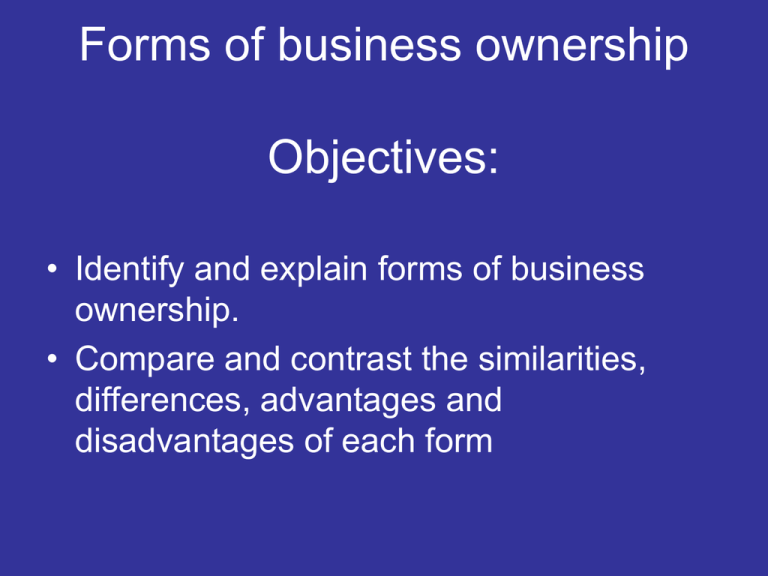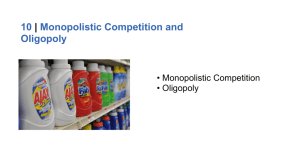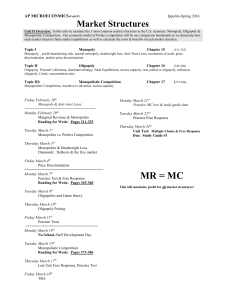Forms of business ownership Objectives:
advertisement

Forms of business ownership Objectives: • Identify and explain forms of business ownership. • Compare and contrast the similarities, differences, advantages and disadvantages of each form Three Types of Business Organizations Sole Proprietorship Partnership Corporation Sole Proprietorships • Facts • The Good – Sole Receiver of Profit – Easy to Start Up – Full Control – Least Regulated – Easy to Stop Operations Sole Proprietorships • The Bad – Unlimited Personal Liability – Lack of Resources – Lack of Permanence Partnerships • The Types – General: 2 or more (infinite) – Limited – Limited Liability – Examples: Law offices, medical practices • Ben-Jarvis Green-Ellis a.k.a “the law firm” Partnerships: The Good • • • • • Ease of Start Up Little Regulation Specialization of Owners Larger Pool of Capital Taxation Advantages Partnerships: The Bad • Unlimited Personal Liability • Potential for Conflict • Division of Assets & Profit Corporations • Types – Closely Held – Publicly Held • The Good – Stockholders Equity – Flexibility, Portability of Stock – Potential for Growth (Stocks/Bonds) – Shareholders Knowledge – Longer Lasting Corporations: The Bad • Difficulty of Start Up – Certificate of Incorporation • Double Taxation • Loss of Control for Stockholders • More Regulation - SEC Other Terms • • • • • Conglomerate Multi-National Franchise Consumer / Producer / Service Coop Non-Profits Economies of Scale • economies of scale are the cost advantages that enterprises obtain due to size, with cost per unit of output generally decreasing with increasing scale Fixed ______ Costs are spread out over as______ more units of output. Objectives: • Identify and explain the different economic market structures • Compare and contrast the similarities and differences of the economic market structures Market Structures • • • • • Monopoly Oligopoly Cartel Monopolistic Competition Monopsony STRUCTURE Monopoly Meaning A situation in which a single company or group owns all or nearly all of the market for a given type of product or service Prices High if true monopoly (illegal), government regulates prices if legal. Absence of competition =high prices & low quality. Characteristics 1 firm, no competition. Although monopolies may be big businesses, size is not a characteristic of a monopoly. A small business may still have the power to raise prices in a small industry Barriers to Entry Governments attempt to prevent monopolies from arising through the use of antitrust laws. Sources of Power Control market. When company increases prices, others may (control over the terms and enter market if they’re able to provide same good or substitute, at lower price conditions of exchange) Examples Public monopolies: ComEd, Nicor. Patents on inventions are monopolies for a period of time (allows recoup of R&D costs). STRUCTURE Oligopoly Meaning An economic market condition where numerous sellers have their presence in one single market. Prices Moderate/fair pricing due to competition in market. But much higher than perfect competition (where there is a large number of buyers and sellers) Characteristics A small number of firms dominate the industry. These firms compete with each other based on product differentiation, price, customer service etc. Barriers to Entry Barriers to entry are very high as it is difficult to enter the industry because of economies of scale. Sources of Power (control over the terms and conditions of exchange) Market making ability because very few firms in industry. Each firm can significantly influence the market by setting price or production quantity. Examples Media co. (radio/tv), wireless providers, grocery store chains, big box stores, cable companies STRUCTURE Cartel Meaning An explicit, formal agreement between firms in an industry to fix price and production quantity. Prices Unusually high prices, fixed by cartel members Characteristics A small number of firms dominate the industry. Prices and production quantities are fixed. Product is undifferentiated. Barriers to Entry Barriers to entry are very high as it is difficult to enter the industry because of economies of scale. Sources of Power (control over the terms and conditions of exchange) Market making ability by an explicit agreement between the dominant players in the industry. Examples OPEC, Federal Reserve STRUCTURE Monopolistic Meaning All firms produce similar yet not perfectly substitutable products Prices Price setter and highly elastic. Characteristics Many producers and many consumers in the market, no business has total control over market price. Consumers perceive that there are non-price differences among the competitors' products. Few barriers exist to entry or exit Barriers to Entry Sources of Power (control over the terms and conditions of exchange) Some degree of market power. Examples Restaurants, cereal, clothing, shoes Government Intervention • Sherman Anti-Trust Act of 1890 – Outlawed mergers and monopolies that limit trade between states. • Breaking up monopolies – Standard Oil in 1911 – AT&T in 1982 • Regulating Unfair Business Practices – Microsoft in 2001 • Blocking Mergers – Supermarket merger research. Current Trend towards “Deregulation” • Starting in 1980’s, Congress began to deregulate certain industries. – Airlines, trucking, banking, railroads, natural gas, TV broadcasting. Game Theory Objective: • Identify and explain the price setting motives of producers in an oligopoly market. What is Game Theory • Determines the actions that “players” should take to secure the best outcomes for themselves in a wide array of “games.” • Games range from chess to child rearing and from tennis to takeovers. But the games all share the common feature of interdependence. • Outcome for each participant depends on the choices (strategies) of all. • In so-called zero-sum games the interests of the players conflict totally, so that one person’s gain always is another’s loss. • More typical are games with the potential for either mutual gain (positive sum) or mutual harm (negative sum). Game Theory Debrief • Prisoner situation – Gamble is not confess – Safe option is to confess, must protect ourselves • Applied to businesses – Coke/Pepsi: make small profit, avoid losing money – Car companies: limit Q on lot = prices high • “Sorry, we only have a few” – Limit production, lower supply, higher price • Best solution collectively is an inferior solution individually • See more: http://www.econlib.org/library/Enc/PrisonersDilemma.ht ml Oligopoly Game Objective: • Apply the strategies of oligopolies while competing in the oligopoly game simulation. Oligopoly Game Directions: 1. Each person is in a group of 4-5, an oligopoly. Each firm is producing widgets with the goal of profit maximization. 2. You will begin with $100 capital and receive a new production cost card each round Oligopoly Game Directions: 3. The forecast of demand will be displayed on the board. This is just a projection but is pretty accurate. An actual demand chart will be posted after you turn in your production. 4. Each team determines production and turns in cards with the number of widgets they’re producing this cycle (round). Oligopoly Game Directions: 5. Actual demand will be posted. 6. Record actual profit on your balance sheet (all team members do this). 7. Get new cost cards and repeat process for each round. GOAL: Produce the most profitable amount of widgets Oligopoly Game Objective: • Apply the strategies of oligopolies while competing in the oligopoly game simulation.




